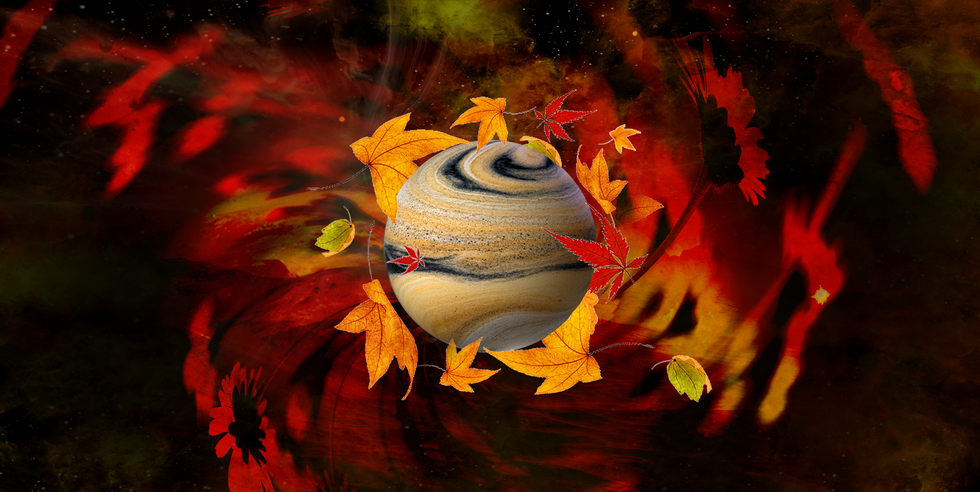
How to Celebrate Mabon
Mark your calendar for September 23 and start making plans to celebrate Mabon. Ma-what? Mabon takes place on the fall equinox. It’s a pagan celebration originating from the ancient Celts, who populated Britain and much of Northwest Europe before the march of the Romans (so we’re going back nearly 2,000 years here). This group of druidic, tree-lovin’ people celebrated the Earth’s cycles and seasons by dividing the year into eight segments at key seasonal turning points, creating eight festivals that are . Got all that? Okay, good. What Is Mabon? Mabon is essentially a harvest festival. Ancient Celts and pagans used this day to give thanks to nature for a good harvest and to pray to their gods and goddesses that the crop would last throughout the winter. There’d be feasting, fires, offerings, and sacrifices. The usual pagan party. Today, the fall equinox is a time to get cozy (say hello to pumpkin spice lattes, s’mores, giant cardigans, and not going ~ out~), focus on the home, give thanks for security, and share with others. When Is Mabon? The exact date of Mabon varies from year to year, but it always falls on the same day as the fall equinox. ICYDK, the fall equinox is a time when day and night are of equal length, in terms of daylight. The fall equinox marks the official start of fall, the first day of Libra season, and yes, Mabon. The exact date can fall anytime between September 22 and 24, depending on the year. In 2023, it's on September 22. What's the Wheel of the Year? From ancient times, people around the world have marked seasonal turning points, using them as opportunities to give thanks, reflect on what they've reaped, and prepare for what they will sow next. It's a balancing and nature-aligning way to live life in tune with the rhythm of the earth’s life cycles. Although these turning points have varied from culture to culture, Wiccans and other neo-pagans follow the schedule set out in the something called " ." The Wheel of the Year is an annual cycle of eight festivals, which divide the year into eight "sections." The start of each is marked by a festival that is celebrated individually and collectively as a community. Mabon is one of eight festivals of the Wheel of the Year. The other seven fall on the spring equinox (Ostara), the summer solstice (Litha), the winter solstice (Yule), and the four midpoints, or “cross-quarters,” that are halfway between a solstice and an equinox (these are called Imbolc, Beltain, Lammas, and ). Marking these festivals can be a simple reminder of all you have to be grateful for, a reason to gather with others, and a nudge to plan things to look forward to and work towards in the season ahead. Use the Wheel of the Year to mark the passage of time in your world mindfully. In Celtic folklore, the name Mabon (although some historians dispute this) is thought to come from , who was the son of the Earth Mother Goddess and a god of light himself. In British folklore, Mabon is associated with and the start of deer-hunting season. Today, some modern-day celebrants honor " " during Mabon. This is a goddess archetype that speaks to our shadow side—the parts of ourselves we don't always like to recognize, but are still there. In different cultures, this goddess has different names: the Crone, Persephone, Chumunda, Hecate, and Kali are some of them. Many cultures celebrate some kind of harvest festival near the fall equinox. There’s Oktoberfest in Germany, Mid-Autumn Festival in China, Mehregan in Iran, and even American Thanksgiving was originally on October 3 (much closer to the actual harvest season). Do You Have to Be Wiccan to Celebrate Mabon? Not at all! While Wiccans and other neo-pagans may choose to honor specific gods and goddesses or incorporate certain rituals, cultures worldwide celebrate harvest festivals. If you want to in some way, whether it's inviting friends over for dinner or just treating yourself to a pumpkin spice latte, go for it. At its core, Mabon is all about gratitude for what has been reaped this year, with an eye to the hardships of winter. It also brings a recognition of a mental and physical adjustment needed for the darker, longer nights and harder conditions ahead. Here are a few ways to celebrate. Apples are a common symbol of Mabon, so bring them into your home as fresh fruit, juice or cider, delicious warm pies or pastries, or even scented candles. Apple up! Set intentions for Mabon Some people like to use this holiday as an occasion to set intentions, especially those around decreasing something, like giving up a bad habit. You could also choose an intention with some other connection to the changing seasons and deceasing light, like getting to bed earlier! Like spring, Mabon is a great time to clean up at home. After all, you’re probably going to be spending more time here over fall and winter. Finish any lingering projects and clear out emotional and physical clutter so that your home feels calm, relaxing, and peaceful. Do you have a collection of beautiful notebooks you’ve never written in? Get one out and start a . Write down everything that happens that you feel happy about or grateful for. I guarantee this will help brighten your mood. Plus, it signals to the universe that you’d like MORE of the same, please. Try hosting a Mabon harvest dinner. Get everyone to bring their favorite food or drink and share with each other. Show off your altar. Start some happy discussions about what you’re grateful for in the past year. Aim to create a warm, cozy pre-Thanksgiving vibe—but much more relaxed. Pick a cause or campaign that you feel strongly about, and give them some of your time, energy, or money. Better yet, think of a way you can give ongoing support throughout the whole year. Choose a ritual If you want to add some magick to your celebrations, choose a ritual that connects to the holiday and/or your intention. Consider practicing or , for example. How to Make a Mabon Altar Any baby pagan or witch knows that is Magick 101. You can make your altar on your kitchen table, windowsill, dresser, fireplace—wherever you have space. An altar can be a space for meditation, spiritual rituals, or simply reflection. You can use any space in your home for an altar, from a special table to a simple windowsill. For Mabon, try adding harvest fruits and vegetables to your altar (like apples, leaves, pine cones, corn, pomegranate, squash, and root vegetables—go ahead, add a pumpkin if you must). Color-wise, you’re looking for gold, orange, red, bronze, and rust. For scents, you’re seeking sage, cinnamon, orange, and apple. , particularly in shades of green or brown, will add a good vibration. Make it look welcoming, pretty, and festive. Light an on your altar and give thanks for the security, happiness, and the advantages you have in your life. There are many symbolic items you can use to create a Mabon altar, table centerpiece, wreath, or piece of art to adorn your home and bring in the positive energy of this festival. I like to focus on items that are locally found or that hold some resonance to me personally. You can personalize your own Mabon creation to represent what you enjoy most about this season. Here are some ideas to get you started: Kerry Ward has been reading and teaching tarot for over 25 years. You can , which comes as a beautifully illustrated brochure, or . Follow her on Instagram @ for weekly forecasts, insights, and tarot teachings. (she/her) is the current Senior Astrology Editor at . In her 2+ years at , she's worked on everything from editing weekly horoscopes, to reporting on how astrology influences album release dates, to launching . Before joining Cosmopolitan in 2020, she was a writer and/or editor for Refinery29, HelloGiggles, and BUST magazine. Her book was published in 2021. Follow her on and @erikawynn.









